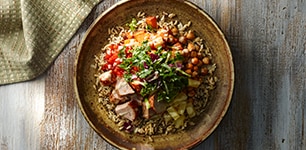Updated March 1, 2022
Women have unique health issues and nutritional needs. Women should enjoy a variety of foods such as whole grains, fruits, vegetables, unsaturated fats, low-fat dairy, and lean protein for their nutrition. Women also have special nutrient needs, and during each stage of a woman's life, these needs change. Read on for tips about nutrients that are important during certain life stages.

Young girls and teenage girls.
Pre- and postmenopausal.
Sources
1 What is Osteoporosis and What Causes It? Bone Health & Osteoporosis Foundation (BHOF). Accessed January 26, 2022.
2 U.S. Department of Health and Human Services (HHS). Iron Fact Sheet for Health Professionals. National Institutes of Health: Office of Dietary Supplements. March 30, 2021.
3 U.S. Department of Health & Human Services. Calcium Fact Sheet for Health Professionals. National Institutes of Health: Office of Dietary Supplements. November 17, 2021.
4 U.S. Department of Health & Human Services. Vitamin D Fact Sheet for Consumers. National Institutes of Health: Office of Dietary Supplements. August 17, 2021.
5 U.S. Department of Health & Human Services. Folate Fact Sheet for Health Professionals. National Institutes of Health: Office of Dietary Supplements. March 29, 2021.
6 U.S. Food & Drug Administration. Advice About Eating Fish for Those Who Might Become or Are Pregnant or Breastfeeding and Children Ages 1 - 11 Years. FDA.gov. October 2021.
7 U.S. Department of Health & Human Services. Omega-3 Fatty Acids Fact Sheet for Health Professionals. National Institutes of Health: Office of Dietary Supplements. August 4, 2021.
8 Sarafrazi, Neda, Edwina Wambogo, and John A. Shepherd. Osteoporosis or Low Bone Mass in Older Adults: United States, 2017–2018. Centers for Disease Control and Prevention (CDC): National Center for Health Statistics. March 2021.
9 Estrogen, Hormone Therapy, and Menopause. American Heart Association. Accessed January 26, 2022.

 You are about to leave publix.com and enter the Instacart site that they operate and control. Publix’s delivery and curbside pickup item prices are higher than item prices in physical store locations. Prices are based on data collected in store and are subject to delays and errors. Fees, tips & taxes may apply. Subject to terms & availability. Publix Liquors orders cannot be combined with grocery delivery. Drink Responsibly. Be 21. For prescription delivery, log in to your pharmacy account by using the Publix Pharmacy app or visiting
You are about to leave publix.com and enter the Instacart site that they operate and control. Publix’s delivery and curbside pickup item prices are higher than item prices in physical store locations. Prices are based on data collected in store and are subject to delays and errors. Fees, tips & taxes may apply. Subject to terms & availability. Publix Liquors orders cannot be combined with grocery delivery. Drink Responsibly. Be 21. For prescription delivery, log in to your pharmacy account by using the Publix Pharmacy app or visiting 
